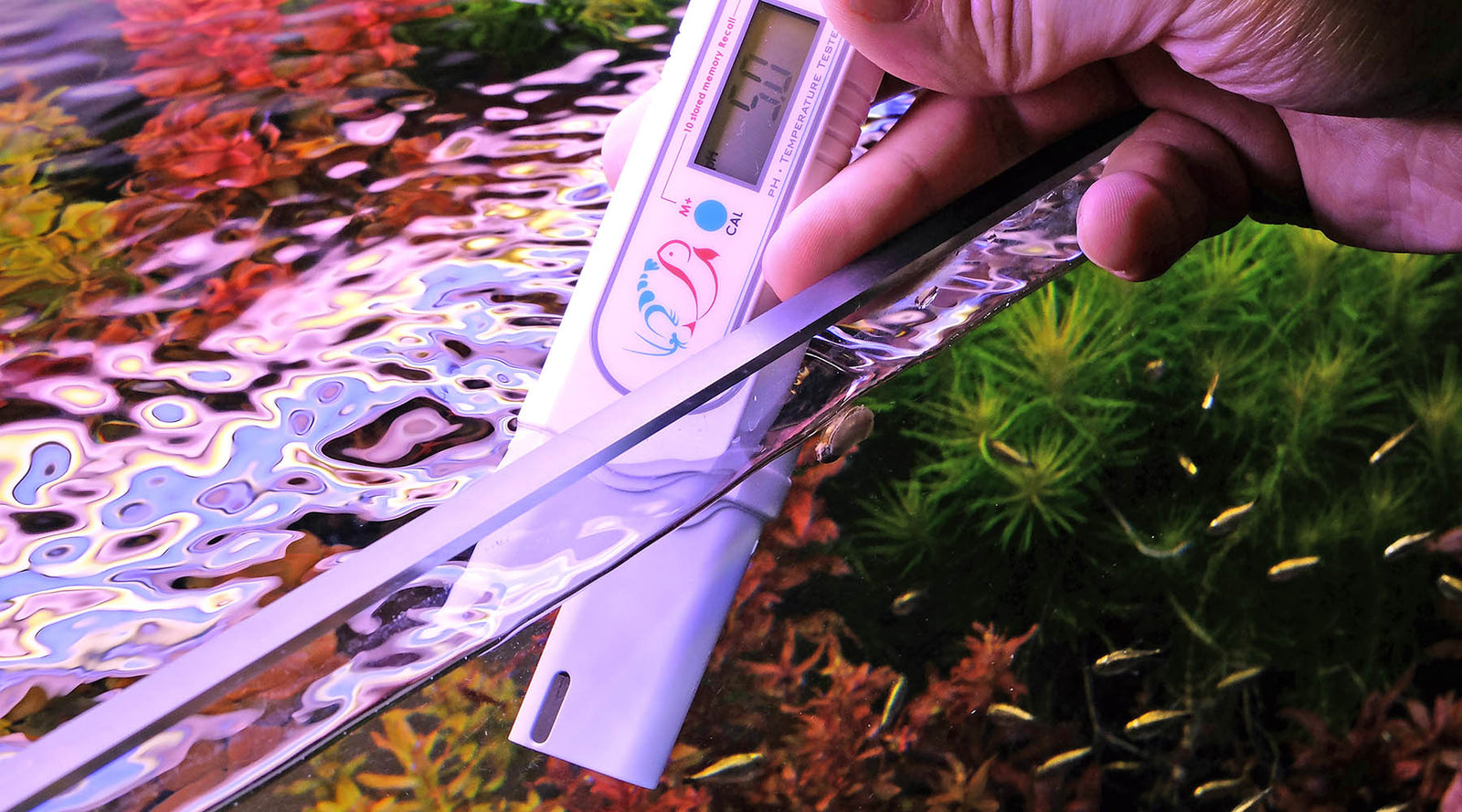Your Cart is Empty
Local Shipping within US, Canada, EU and Australia
Menu

Local Shipping within US, Canada, EU and Australia
Are bacteria affected due to low pH/KH in aquasoil tanks?
July 25, 2025 7 min read

2Hr Farm tanks typically have a pH of 5.0 when the CO2 is turned on. How do such low pH tanks function?
Why do certain planted tanks have such low pH?
Aquariums with aquasoil in soft water countries naturally have very low pH values. This is by design, as most aquatic plants prefer slightly acidic substrates. This environment is also favored by many fish species that also come from soft water, low pH rivers such as those found in the Amazon. Peat is included in most aquasoil - it lowers the acidity of the water and also reduces the KH levels in the tank. For many brands of aquasoil, this buffering capacity can reduce KH to unmeasurable levels; this correspondingly lowers the pH, often to the 6+ range (which then drops to the 5+ range when CO2 is switched on, as dissolved CO2 is acidic).


Super soft water is preferred by many picky species. Hyphessobrycon myrmex (Fire ant tetra) above shows better colouration in soft, acidic water. Aquarium above is at pH 5.46, with KH of less than 1.
Doesn't low pH harm bacteria?
At 2hr Aquarist we performed this study where we removed the contents of a running planted tank, and tested to see if the filter alone would be able to eliminate ammonia. The tank was still connected up to a CO2 injection system, which we utilized to suppress the pH to 5.2 (when CO2 is at its peak) to 5.9 (when CO2 is turned off). Ammonium sulphate was dosed to build up the microbial colonies similar to cycling a tank. We do this as previously when there were plants competing in the uptake of ammonia, microbial action took a backseat.
In a week plus, microbial activity ramped up to being able to digest 0.8ppm of ammonia across a 24hour window, all while the pH is kept suppressed below pH 6.


There are many different microbes in aquatic systems. Well studied strains of ammonia oxidising bacteria (AOB) such as Nitrosomonas, function more optimally at higher pH/KH ranges. However, they are not the only microbes that feed off ammonia. In low pH systems, ammonia oxidizing archaea (AOA) play a more dominant role instead. Acidic aquariums do cycle, but the strains of microbes that propagate are ones that are suited to operating in acidic environments. There are far more types and strains of microbes (bacteria, fungi and archaea etc) than aquarists can account for. Many of these have adaptations to low pH environment, such as the use of bio-films to alter their immediate environment as shown in this article.
In short, ammonia oxidation does not stop in acidic low pH aquariums. Acidic environments may take longer to develop a cycle, and the microbial mix is quite different from that of higher pH/KH environments.
Allowing a tank to cycle at a high pH levels cultivates bacteria that are optimized to high pH/KH levels. Suddenly dropping the pH by huge amount will affect the way they function. This is a very different scenario from allowing a low pH tank to mature naturally at a low pH.


Why is low pH associated with tanks crashing
Very low pH/KH levels cause some concern among aquarists who fear that such a low pH will affect the health of the animals or bacteria in the tank, as one group of (usually older) aquarists have been taught that dropping/low pH levels in a tank are a sign that something is wrong.
There is some truth to this. In aquariums where there is no CO2 injection/generation, such as fish-only aquariums without plants, non-intentional changes in pH can signal deteriorating biological conditions which can be major red flags. A mass fish die off for example, will drive up carbon dioxide levels through decomposition, while depleting oxygen levels at the same time. This results in the pH dropping precipitously. The depletion of oxygen and deterioration of water quality is often what affects aquarium inhabitants. The change in pH is merely a symptom of underlying problems - and rarely the cause of problems by itself. Unfortunately, this has given rise to the myth that pH swings are deadly by themselves, a statement that clearly mistakes symptoms for causation.
Bacterial oxidation of ammonia to nitrates consumes carbonates (which lowers KH/pH); although this effect is small, it can be significant over long periods of time. Organic waste by-products are also acidic, again the effect is small but the accumulation over time can be significant. The build up of organic waste can cause the KH/pH levels of a poorly maintained tank to drop over time. This is very different from aquariums that make use of inherently acidic aquasoils.
Should I buffer my aquasoil tank to raise the pH/KH?
You should not because you should let the aquarium propagate microbes that are naturally suited to the low pH/KH environment.
Plants do not use KH (except for certain niche species) and most plants actually function better at low ranges, as do most soft water fish. Many buffers also use phosphate based chemicals which will raise your PO4 levels significantly. Working against aquasoils is also counterproductive - adding carbonate buffers to the tank will see only a short term spike in pH/KH, which will drop over time as the aquasoil absorbs the KH.

Many pickier plant species such as Eriocaulons, Syngonanthus and picky Rotala species do better at very low KH ranges (<2dKH).
If you are keeping animals that require hard water, then aquasoils that buffer down KH/pH should not be used in the first place. For tanks containing animals that prefer hard water, aquasoils should be avoided and inert or limestone based substrates can be used in the tank instead. Many African rift-lake cichlids, some species of snails and shrimps prefer hard water and their tank should be set up to provide this environment.
We asked researcher Sudipta Shaw about increasing KH in aquasoil tanks to combat the the low pH conditions, this was his answer:
"I don't see any compelling reason to increase KH for plant centric tanks with livestock not requiring alkaline conditions, especially if someone is using aquasoil. I think there are two primary reasons why many people advocate for high KH; One is this so called fascination about select groups of nitrifying bacteria, which don't exist in any meaningful way in most healthy tanks including tanks with higher KH (in plant centric tanks with livestock not picky about KH). As far as I know, healthy tanks generally don't produce enough ammonia to sustain a huge population of these bacteria because their enzymes have low affinity for ammonia, they need higher ammonia concentration to thrive. That's why these are primarily found in decent numbers in waste water treatment facilities and contaminated water bodies. There are several scientific studies on healthy freshwater systems including aquariums which show that these popular nitrifying bacteria (in the hobby) are not the primary nitrifying microbes (particularly for the first and the most difficult reaction that is conversion of ammonia to nitrite). I have done two separate DNA analysis from multiple tanks and I see the same thing. Not even a single tank showed any meaningful presence of these legendary nitrifying bacteria. Another reason for many people to stay obsessed with this higher KH theory is that they find it difficult to comprehend that KH is not the only factor that can maintain a stable pH (buffering capacity). Tanks with aquasoil also maintain a stable but low pH for decent amount of time. There are other factors as well such as application of phosphate as fertilizers for plants. Phosphate is a common buffer and is one of the primary buffers used in biochemical research. When applied on a regular basis as fertilizer in tanks with regular maintenance (weekly water change, substrate cleaning etc.), it can also maintain a stable pH in tanks with inert substrates with almost 0 dKH as well. This would mainly apply to people who dose ei. The point is, it is certainly possible to maintain low and stable pH in planted tanks which should be the main objective rather than getting obsessed about achieving some magical pH by increasing KH. I have not even mentioned about the effects on CO2 uptake by plants in higher KH water and potential negative effects on Fe and other metal uptake mechanism. There is a reason why most people struggle to grow plants in relatively higher KH water."
GH is separate from KH. GH comprises mostly of Ca and Mg ions, which plants use as nutrients for growth. To read more on GH head here
To read more on pH swings how they affect/not affect livestock head here
Studying low pH/KH aquasoil tanks from soft water countries
Many countries are pre-dominantly soft water or very soft water (between 0-2 dKH out of tap). Japan, parts of Indonesia, Singapore, Malaysia all have soft tap water in most areas. Most planted aquariums use aquasoil in these regions and the combination of aquasoil plus soft tap water means that low pH/KH tanks are the norm for planted aquarium in such countries. These tanks do very well in terms of both plant and fish health, and the low pH/KH environment does not present any more issues than more alkaline tanks elsewhere. If anything, the super soft water seems to give better success with many picky plant species.


Low pH systems in nature
There are many rivers in the world where the pH is naturally low. These include measurements in the Amazon basin, where areas of the Tapjos basin have a pH of 4.39, and the Tefe River has a pH of 5.03. The Tasek Bera River in Malaysia measures 5.33. This is a basket of spot readings, but these rivers are not outliers, such readings are common in soft water regions. All these rivers are also less than 1 dKH. These rivers are teeming with plants and fish - they are not wastelands where ammonia oxidation does not take place because "bacteria cannot survive below X pH".

Wild Toninas (above) in pH 3.2 black water swamps, coupled with Eleocharis species (below). Photos courtesy of Vin kutty.

More low pH/KH tank examples from all around the world
As it is, we have a collection of examples of low pH/KH tanks from all four corners of the world. From a practical point of view, if this approach can be repeated with great success on four continents, hobbyists can be sure it will work for them.
 Tom barr's tank has a pH of 5.6 when CO2 injection is on.
Tom barr's tank has a pH of 5.6 when CO2 injection is on.
 Gregg Zydeck's tank has a pH of 5.4 when CO2 is on, KH1.
Gregg Zydeck's tank has a pH of 5.4 when CO2 is on, KH1.
 Steve Tousignant has a KH of 0.
Steve Tousignant has a KH of 0.
 Paulina Zagorowska has a KH of 0
Paulina Zagorowska has a KH of 0
 Hugo Alves tank has a pH of 5.8.
Hugo Alves tank has a pH of 5.8.

Daniel Constantin's tank has a KH of 0.
 Rory Funch's tank has a KH of 1.
Rory Funch's tank has a KH of 1.
 Joe Harvey's tank has a KH of 1.
Joe Harvey's tank has a KH of 1.
 Adam Wolferman Sr.'s tank has a KH of 1.
Adam Wolferman Sr.'s tank has a KH of 1.
unlock your true potential
Grow anything, defeat algae, create amazing aquascapes
























